Administrative Implementation Plan: Financial & Payroll System Report
VerifiedAdded on 2020/03/04
|18
|3747
|257
Report
AI Summary
This report presents a comprehensive administrative system implementation plan, encompassing a Gantt chart outlining project activities and timelines. The plan utilizes a parallel and phased rollout approach for implementation, discussing the advantages and considerations of this method. It details consultation processes, including surveys and communication hierarchies, to engage stakeholders. The report also outlines proposed training programs for both existing and new staff, covering various training methods and materials. A thorough risk assessment is conducted, identifying potential challenges such as system knowledge gaps and resistance to change, alongside contingency plans to mitigate these risks, like IT support and data backups. The report emphasizes the importance of stakeholder communication and the need for continuous monitoring and evaluation to ensure the successful implementation of the new financial and payroll administrative system.
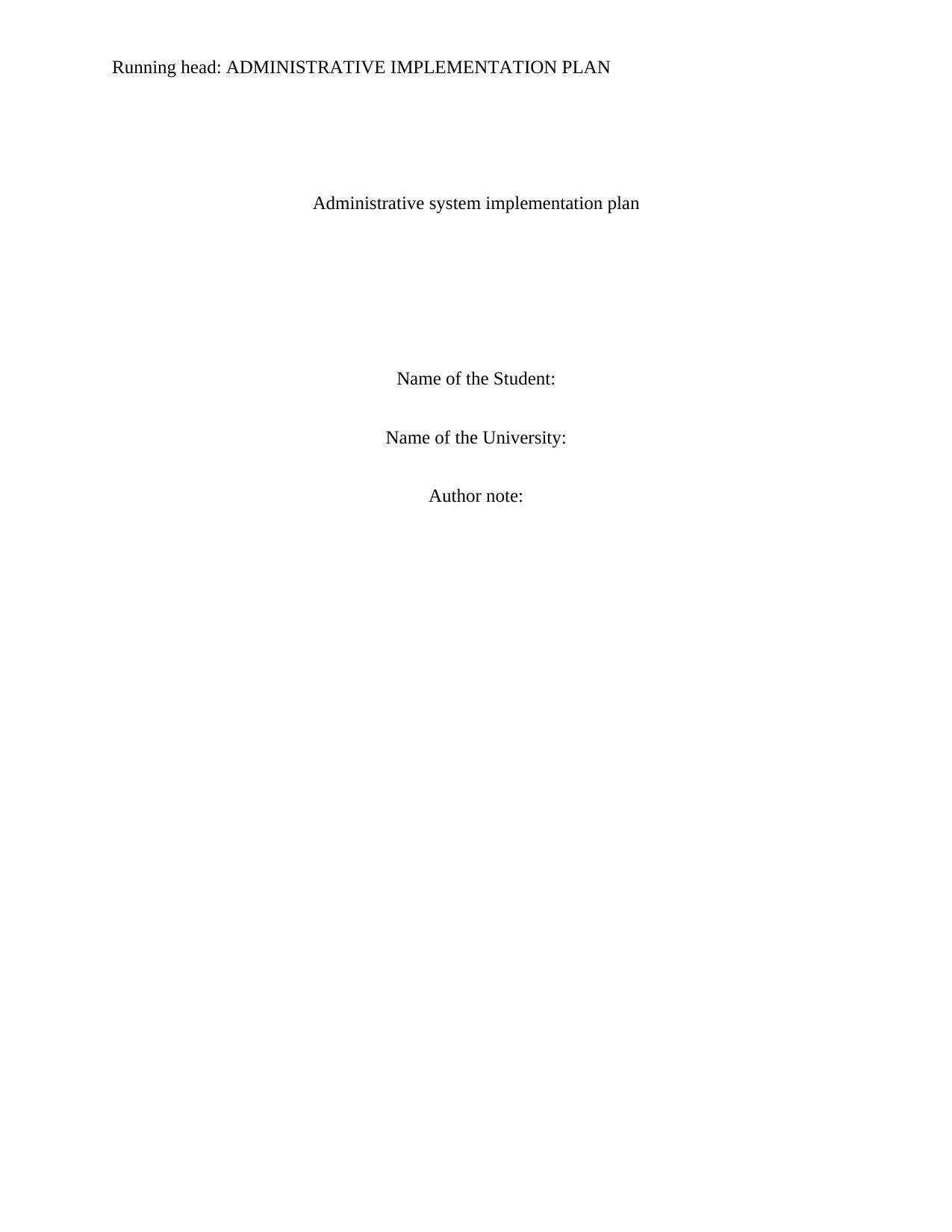
Running head: ADMINISTRATIVE IMPLEMENTATION PLAN
Administrative system implementation plan
Name of the Student:
Name of the University:
Author note:
Administrative system implementation plan
Name of the Student:
Name of the University:
Author note:
Paraphrase This Document
Need a fresh take? Get an instant paraphrase of this document with our AI Paraphraser
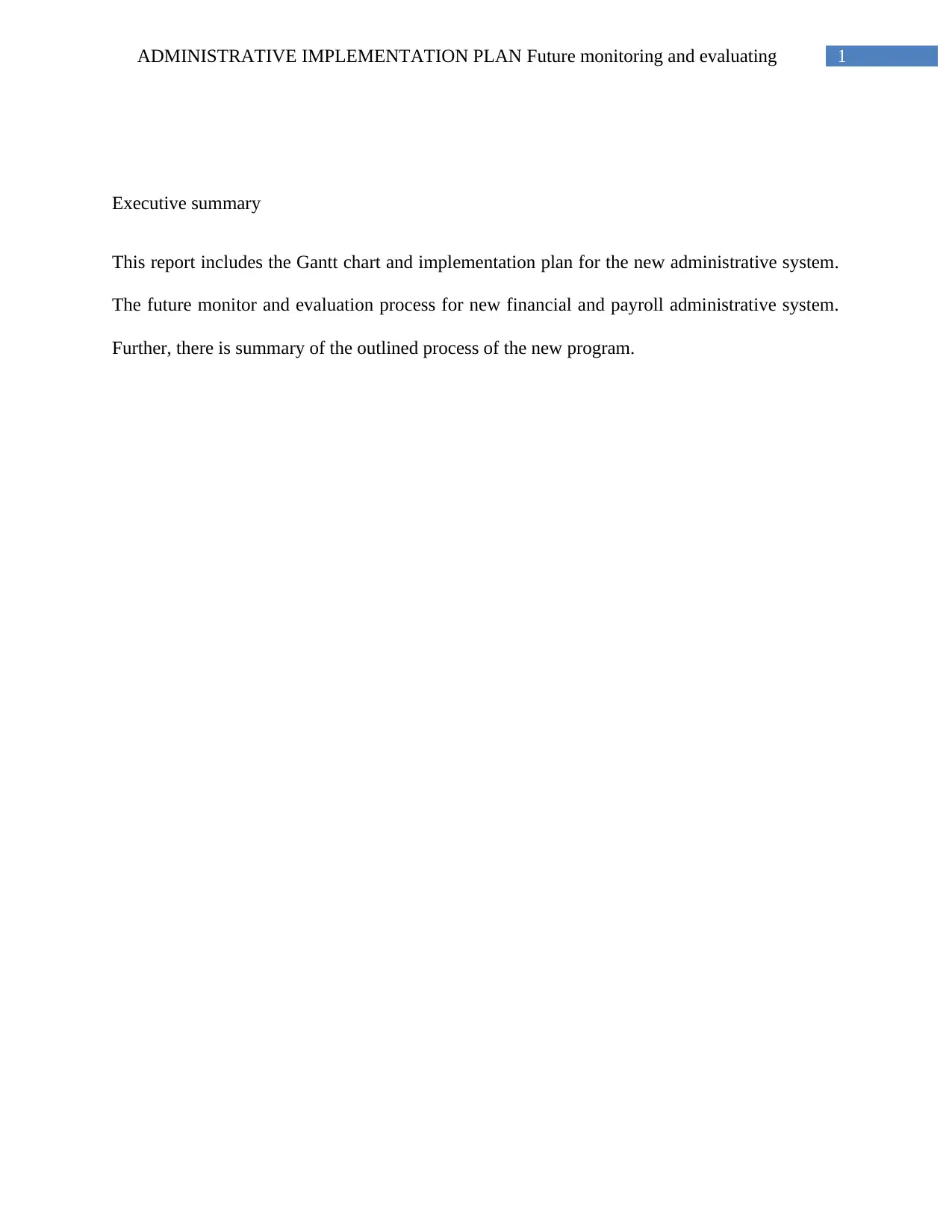
1ADMINISTRATIVE IMPLEMENTATION PLAN Future monitoring and evaluating
Executive summary
This report includes the Gantt chart and implementation plan for the new administrative system.
The future monitor and evaluation process for new financial and payroll administrative system.
Further, there is summary of the outlined process of the new program.
Executive summary
This report includes the Gantt chart and implementation plan for the new administrative system.
The future monitor and evaluation process for new financial and payroll administrative system.
Further, there is summary of the outlined process of the new program.
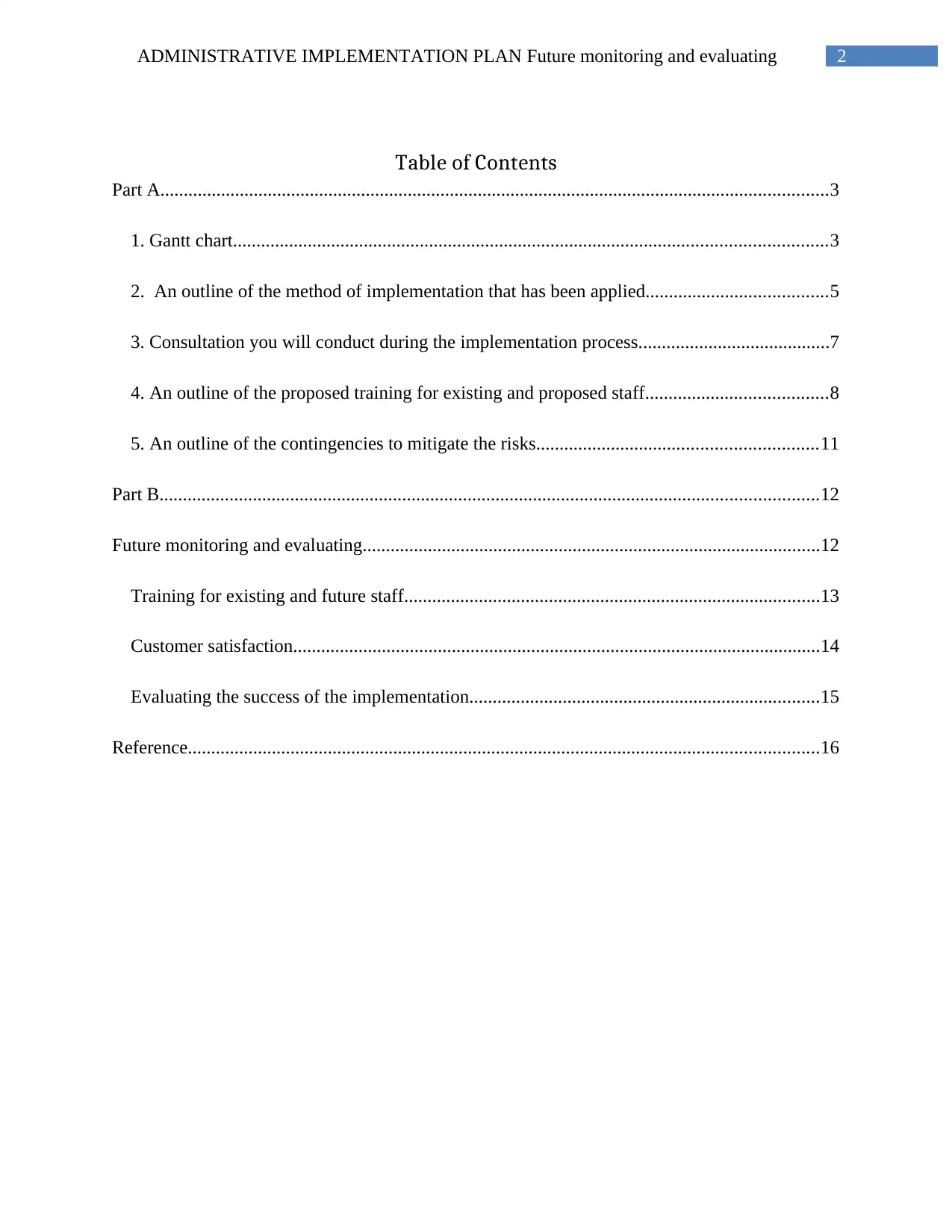
2ADMINISTRATIVE IMPLEMENTATION PLAN Future monitoring and evaluating
Table of Contents
Part A...............................................................................................................................................3
1. Gantt chart...............................................................................................................................3
2. An outline of the method of implementation that has been applied.......................................5
3. Consultation you will conduct during the implementation process.........................................7
4. An outline of the proposed training for existing and proposed staff.......................................8
5. An outline of the contingencies to mitigate the risks............................................................11
Part B.............................................................................................................................................12
Future monitoring and evaluating..................................................................................................12
Training for existing and future staff.........................................................................................13
Customer satisfaction.................................................................................................................14
Evaluating the success of the implementation...........................................................................15
Reference.......................................................................................................................................16
Table of Contents
Part A...............................................................................................................................................3
1. Gantt chart...............................................................................................................................3
2. An outline of the method of implementation that has been applied.......................................5
3. Consultation you will conduct during the implementation process.........................................7
4. An outline of the proposed training for existing and proposed staff.......................................8
5. An outline of the contingencies to mitigate the risks............................................................11
Part B.............................................................................................................................................12
Future monitoring and evaluating..................................................................................................12
Training for existing and future staff.........................................................................................13
Customer satisfaction.................................................................................................................14
Evaluating the success of the implementation...........................................................................15
Reference.......................................................................................................................................16
⊘ This is a preview!⊘
Do you want full access?
Subscribe today to unlock all pages.

Trusted by 1+ million students worldwide
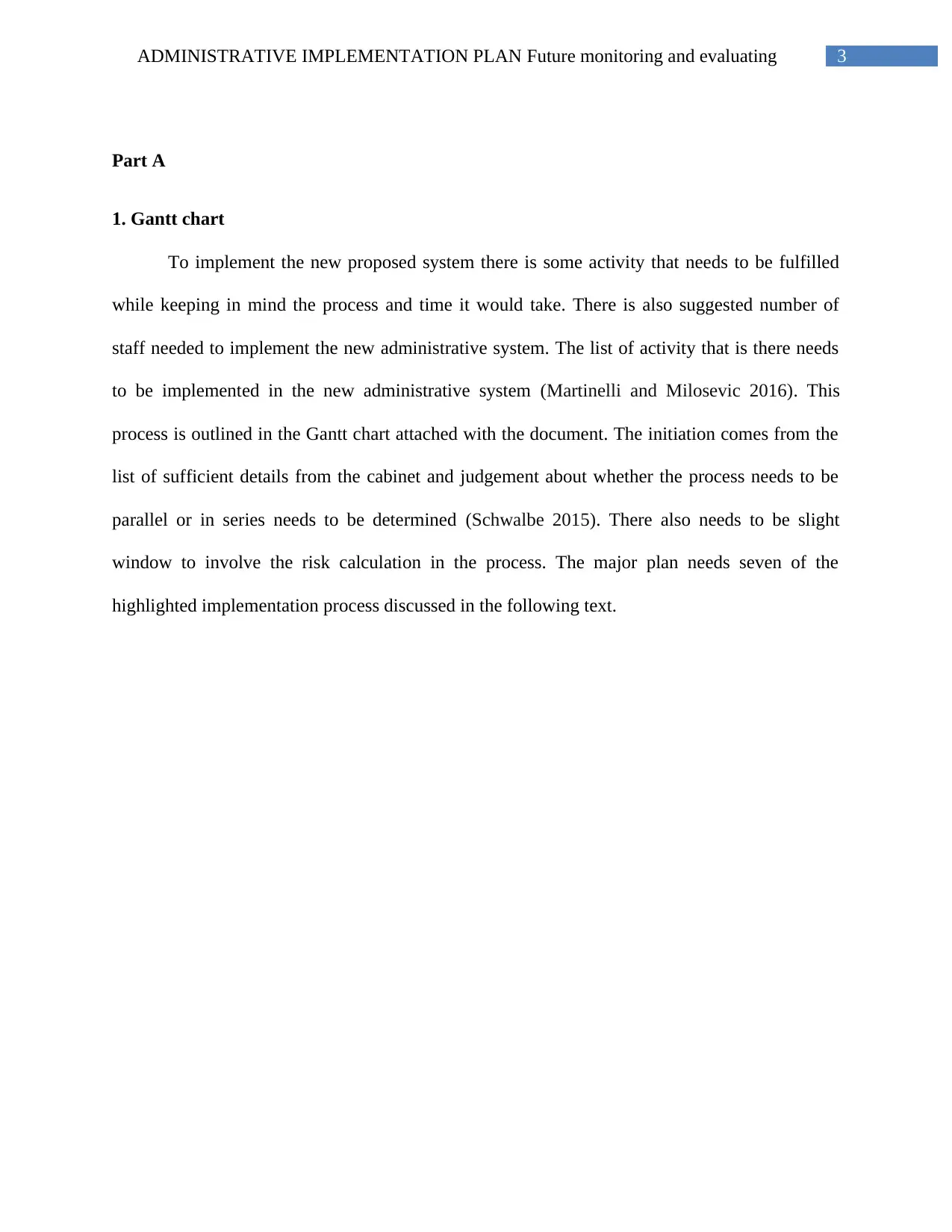
3ADMINISTRATIVE IMPLEMENTATION PLAN Future monitoring and evaluating
Part A
1. Gantt chart
To implement the new proposed system there is some activity that needs to be fulfilled
while keeping in mind the process and time it would take. There is also suggested number of
staff needed to implement the new administrative system. The list of activity that is there needs
to be implemented in the new administrative system (Martinelli and Milosevic 2016). This
process is outlined in the Gantt chart attached with the document. The initiation comes from the
list of sufficient details from the cabinet and judgement about whether the process needs to be
parallel or in series needs to be determined (Schwalbe 2015). There also needs to be slight
window to involve the risk calculation in the process. The major plan needs seven of the
highlighted implementation process discussed in the following text.
Part A
1. Gantt chart
To implement the new proposed system there is some activity that needs to be fulfilled
while keeping in mind the process and time it would take. There is also suggested number of
staff needed to implement the new administrative system. The list of activity that is there needs
to be implemented in the new administrative system (Martinelli and Milosevic 2016). This
process is outlined in the Gantt chart attached with the document. The initiation comes from the
list of sufficient details from the cabinet and judgement about whether the process needs to be
parallel or in series needs to be determined (Schwalbe 2015). There also needs to be slight
window to involve the risk calculation in the process. The major plan needs seven of the
highlighted implementation process discussed in the following text.
Paraphrase This Document
Need a fresh take? Get an instant paraphrase of this document with our AI Paraphraser
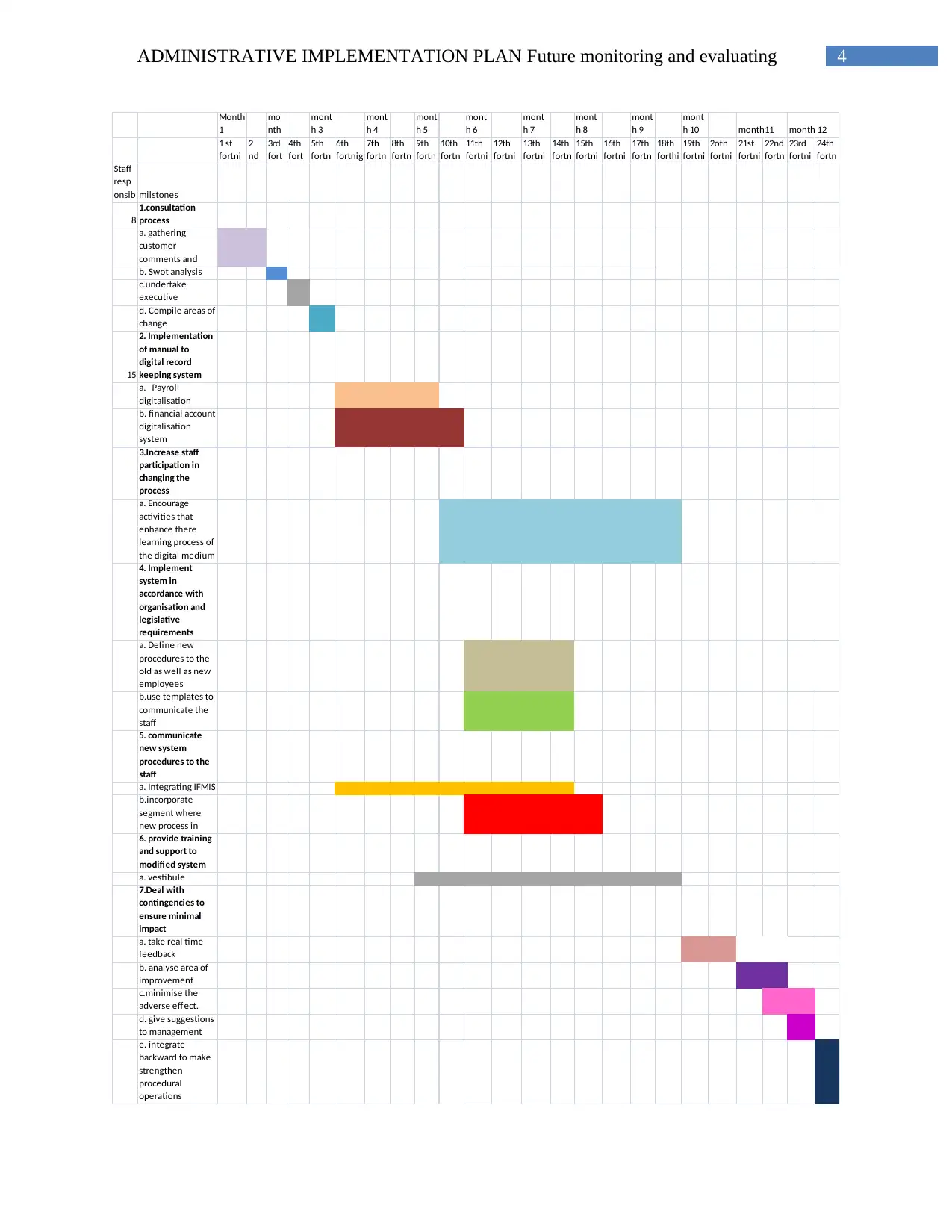
4ADMINISTRATIVE IMPLEMENTATION PLAN Future monitoring and evaluating
Month
1
mo
nth
mont
h 3
mont
h 4
mont
h 5
mont
h 6
mont
h 7
mont
h 8
mont
h 9
mont
h 10 month11 month 12
1 st
fortni
2
nd
3rd
fort
4th
fort
5th
fortn
6th
fortnig
7th
fortn
8th
fortn
9th
fortn
10th
fortn
11th
fortni
12th
fortni
13th
fortni
14th
fortn
15th
fortni
16th
fortni
17th
fortn
18th
forthi
19th
fortni
2oth
fortni
21st
fortni
22nd
fortn
23rd
fortni
24th
fortn
Staff
resp
onsib milstones
8
1.consultation
process
a. gathering
customer
comments and
b. Swot analysis
c.undertake
executive
d. Compile areas of
change
15
2. Implementation
of manual to
digital record
keeping system
a. Payroll
digitalisation
b. financial account
digitalisation
system
3.Increase staff
participation in
changing the
process
a. Encourage
activities that
enhance there
learning process of
the digital medium
4. Implement
system in
accordance with
organisation and
legislative
requirements
a. Define new
procedures to the
old as well as new
employees
b.use templates to
communicate the
staff
5. communicate
new system
procedures to the
staff
a. Integrating IFMIS
b.incorporate
segment where
new process in
6. provide training
and support to
modified system
a. vestibule
7.Deal with
contingencies to
ensure minimal
impact
a. take real time
feedback
b. analyse area of
improvement
c.minimise the
adverse effect.
d. give suggestions
to management
e. integrate
backward to make
strengthen
procedural
operations
Month
1
mo
nth
mont
h 3
mont
h 4
mont
h 5
mont
h 6
mont
h 7
mont
h 8
mont
h 9
mont
h 10 month11 month 12
1 st
fortni
2
nd
3rd
fort
4th
fort
5th
fortn
6th
fortnig
7th
fortn
8th
fortn
9th
fortn
10th
fortn
11th
fortni
12th
fortni
13th
fortni
14th
fortn
15th
fortni
16th
fortni
17th
fortn
18th
forthi
19th
fortni
2oth
fortni
21st
fortni
22nd
fortn
23rd
fortni
24th
fortn
Staff
resp
onsib milstones
8
1.consultation
process
a. gathering
customer
comments and
b. Swot analysis
c.undertake
executive
d. Compile areas of
change
15
2. Implementation
of manual to
digital record
keeping system
a. Payroll
digitalisation
b. financial account
digitalisation
system
3.Increase staff
participation in
changing the
process
a. Encourage
activities that
enhance there
learning process of
the digital medium
4. Implement
system in
accordance with
organisation and
legislative
requirements
a. Define new
procedures to the
old as well as new
employees
b.use templates to
communicate the
staff
5. communicate
new system
procedures to the
staff
a. Integrating IFMIS
b.incorporate
segment where
new process in
6. provide training
and support to
modified system
a. vestibule
7.Deal with
contingencies to
ensure minimal
impact
a. take real time
feedback
b. analyse area of
improvement
c.minimise the
adverse effect.
d. give suggestions
to management
e. integrate
backward to make
strengthen
procedural
operations
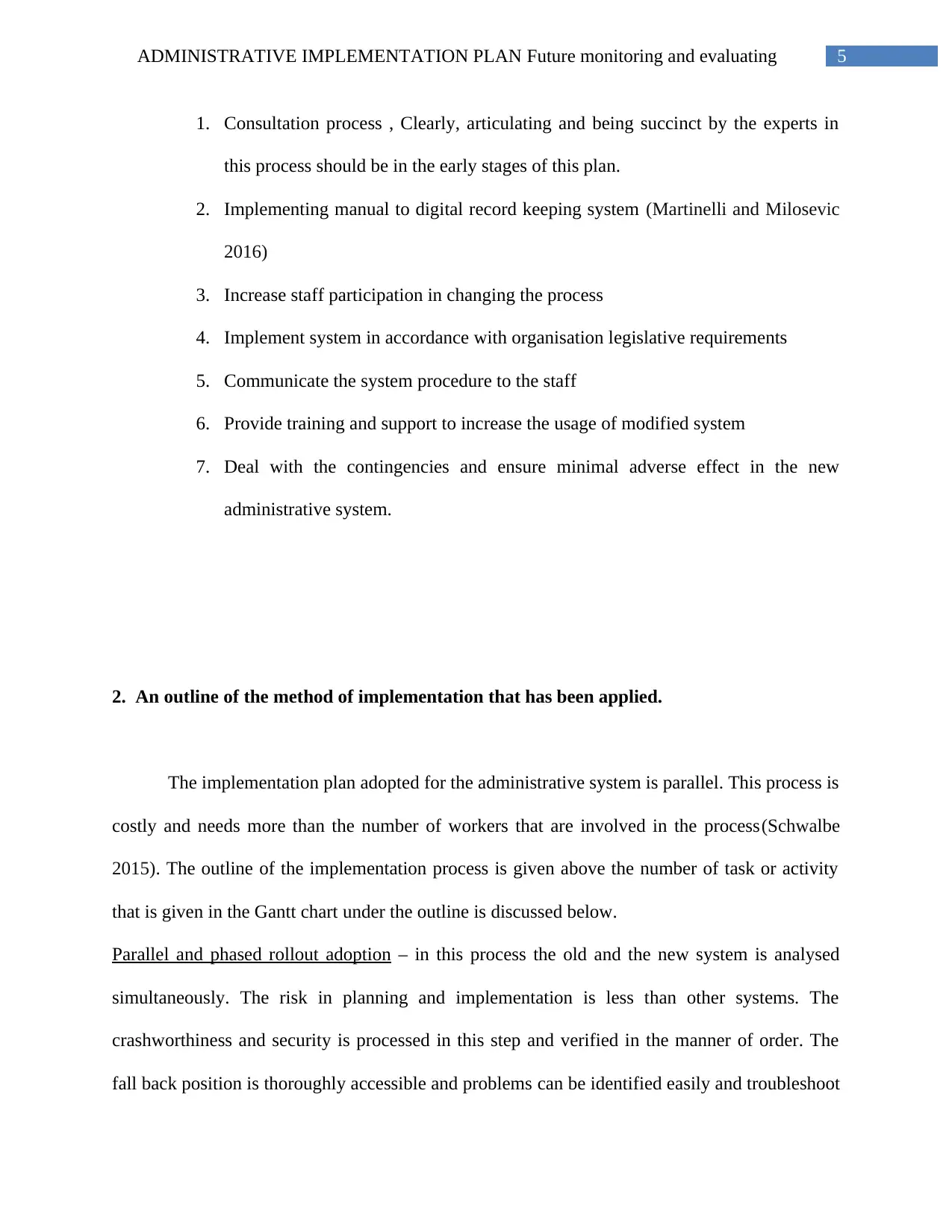
5ADMINISTRATIVE IMPLEMENTATION PLAN Future monitoring and evaluating
1. Consultation process , Clearly, articulating and being succinct by the experts in
this process should be in the early stages of this plan.
2. Implementing manual to digital record keeping system (Martinelli and Milosevic
2016)
3. Increase staff participation in changing the process
4. Implement system in accordance with organisation legislative requirements
5. Communicate the system procedure to the staff
6. Provide training and support to increase the usage of modified system
7. Deal with the contingencies and ensure minimal adverse effect in the new
administrative system.
2. An outline of the method of implementation that has been applied.
The implementation plan adopted for the administrative system is parallel. This process is
costly and needs more than the number of workers that are involved in the process(Schwalbe
2015). The outline of the implementation process is given above the number of task or activity
that is given in the Gantt chart under the outline is discussed below.
Parallel and phased rollout adoption – in this process the old and the new system is analysed
simultaneously. The risk in planning and implementation is less than other systems. The
crashworthiness and security is processed in this step and verified in the manner of order. The
fall back position is thoroughly accessible and problems can be identified easily and troubleshoot
1. Consultation process , Clearly, articulating and being succinct by the experts in
this process should be in the early stages of this plan.
2. Implementing manual to digital record keeping system (Martinelli and Milosevic
2016)
3. Increase staff participation in changing the process
4. Implement system in accordance with organisation legislative requirements
5. Communicate the system procedure to the staff
6. Provide training and support to increase the usage of modified system
7. Deal with the contingencies and ensure minimal adverse effect in the new
administrative system.
2. An outline of the method of implementation that has been applied.
The implementation plan adopted for the administrative system is parallel. This process is
costly and needs more than the number of workers that are involved in the process(Schwalbe
2015). The outline of the implementation process is given above the number of task or activity
that is given in the Gantt chart under the outline is discussed below.
Parallel and phased rollout adoption – in this process the old and the new system is analysed
simultaneously. The risk in planning and implementation is less than other systems. The
crashworthiness and security is processed in this step and verified in the manner of order. The
fall back position is thoroughly accessible and problems can be identified easily and troubleshoot
⊘ This is a preview!⊘
Do you want full access?
Subscribe today to unlock all pages.

Trusted by 1+ million students worldwide
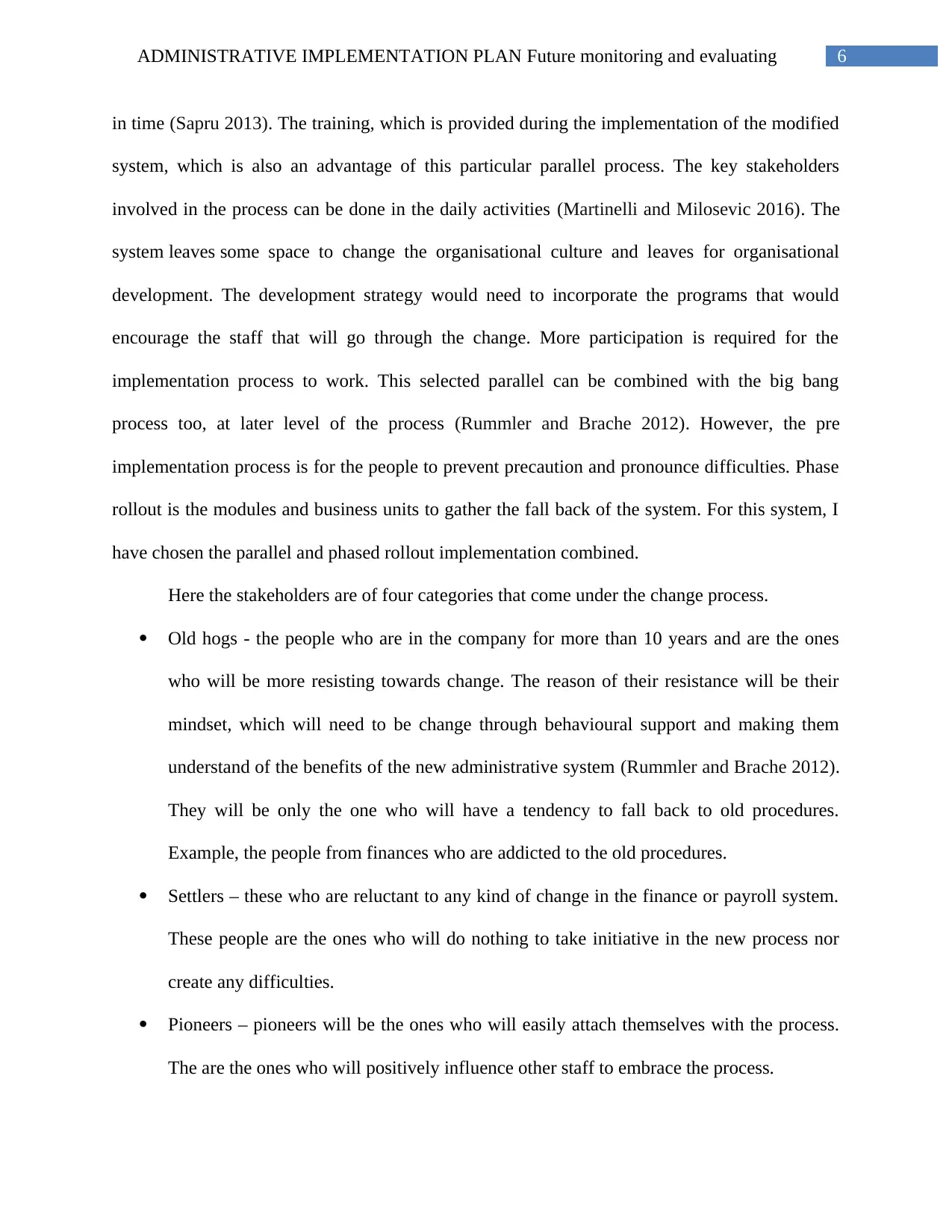
6ADMINISTRATIVE IMPLEMENTATION PLAN Future monitoring and evaluating
in time (Sapru 2013). The training, which is provided during the implementation of the modified
system, which is also an advantage of this particular parallel process. The key stakeholders
involved in the process can be done in the daily activities (Martinelli and Milosevic 2016). The
system leaves some space to change the organisational culture and leaves for organisational
development. The development strategy would need to incorporate the programs that would
encourage the staff that will go through the change. More participation is required for the
implementation process to work. This selected parallel can be combined with the big bang
process too, at later level of the process (Rummler and Brache 2012). However, the pre
implementation process is for the people to prevent precaution and pronounce difficulties. Phase
rollout is the modules and business units to gather the fall back of the system. For this system, I
have chosen the parallel and phased rollout implementation combined.
Here the stakeholders are of four categories that come under the change process.
Old hogs - the people who are in the company for more than 10 years and are the ones
who will be more resisting towards change. The reason of their resistance will be their
mindset, which will need to be change through behavioural support and making them
understand of the benefits of the new administrative system (Rummler and Brache 2012).
They will be only the one who will have a tendency to fall back to old procedures.
Example, the people from finances who are addicted to the old procedures.
Settlers – these who are reluctant to any kind of change in the finance or payroll system.
These people are the ones who will do nothing to take initiative in the new process nor
create any difficulties.
Pioneers – pioneers will be the ones who will easily attach themselves with the process.
The are the ones who will positively influence other staff to embrace the process.
in time (Sapru 2013). The training, which is provided during the implementation of the modified
system, which is also an advantage of this particular parallel process. The key stakeholders
involved in the process can be done in the daily activities (Martinelli and Milosevic 2016). The
system leaves some space to change the organisational culture and leaves for organisational
development. The development strategy would need to incorporate the programs that would
encourage the staff that will go through the change. More participation is required for the
implementation process to work. This selected parallel can be combined with the big bang
process too, at later level of the process (Rummler and Brache 2012). However, the pre
implementation process is for the people to prevent precaution and pronounce difficulties. Phase
rollout is the modules and business units to gather the fall back of the system. For this system, I
have chosen the parallel and phased rollout implementation combined.
Here the stakeholders are of four categories that come under the change process.
Old hogs - the people who are in the company for more than 10 years and are the ones
who will be more resisting towards change. The reason of their resistance will be their
mindset, which will need to be change through behavioural support and making them
understand of the benefits of the new administrative system (Rummler and Brache 2012).
They will be only the one who will have a tendency to fall back to old procedures.
Example, the people from finances who are addicted to the old procedures.
Settlers – these who are reluctant to any kind of change in the finance or payroll system.
These people are the ones who will do nothing to take initiative in the new process nor
create any difficulties.
Pioneers – pioneers will be the ones who will easily attach themselves with the process.
The are the ones who will positively influence other staff to embrace the process.
Paraphrase This Document
Need a fresh take? Get an instant paraphrase of this document with our AI Paraphraser
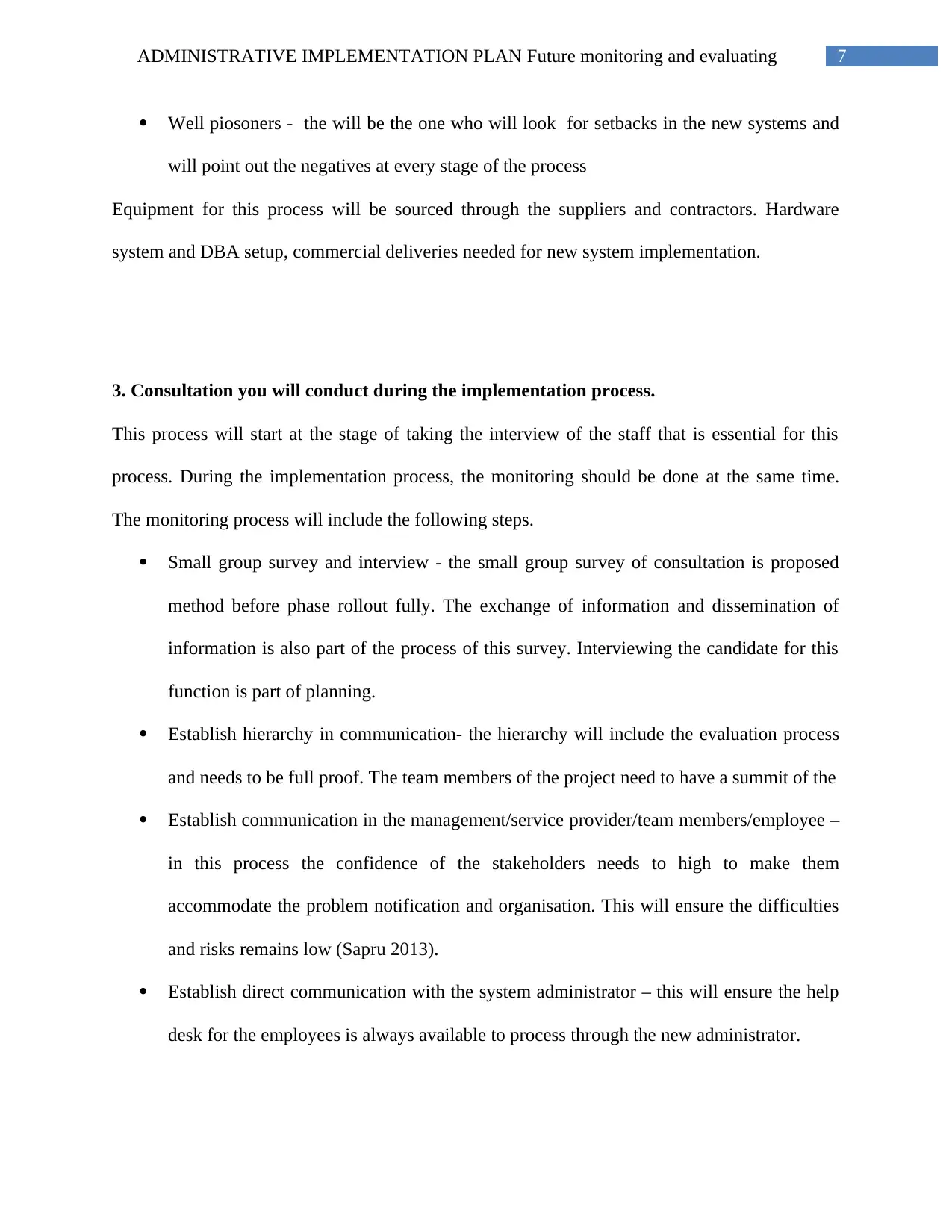
7ADMINISTRATIVE IMPLEMENTATION PLAN Future monitoring and evaluating
Well piosoners - the will be the one who will look for setbacks in the new systems and
will point out the negatives at every stage of the process
Equipment for this process will be sourced through the suppliers and contractors. Hardware
system and DBA setup, commercial deliveries needed for new system implementation.
3. Consultation you will conduct during the implementation process.
This process will start at the stage of taking the interview of the staff that is essential for this
process. During the implementation process, the monitoring should be done at the same time.
The monitoring process will include the following steps.
Small group survey and interview - the small group survey of consultation is proposed
method before phase rollout fully. The exchange of information and dissemination of
information is also part of the process of this survey. Interviewing the candidate for this
function is part of planning.
Establish hierarchy in communication- the hierarchy will include the evaluation process
and needs to be full proof. The team members of the project need to have a summit of the
Establish communication in the management/service provider/team members/employee –
in this process the confidence of the stakeholders needs to high to make them
accommodate the problem notification and organisation. This will ensure the difficulties
and risks remains low (Sapru 2013).
Establish direct communication with the system administrator – this will ensure the help
desk for the employees is always available to process through the new administrator.
Well piosoners - the will be the one who will look for setbacks in the new systems and
will point out the negatives at every stage of the process
Equipment for this process will be sourced through the suppliers and contractors. Hardware
system and DBA setup, commercial deliveries needed for new system implementation.
3. Consultation you will conduct during the implementation process.
This process will start at the stage of taking the interview of the staff that is essential for this
process. During the implementation process, the monitoring should be done at the same time.
The monitoring process will include the following steps.
Small group survey and interview - the small group survey of consultation is proposed
method before phase rollout fully. The exchange of information and dissemination of
information is also part of the process of this survey. Interviewing the candidate for this
function is part of planning.
Establish hierarchy in communication- the hierarchy will include the evaluation process
and needs to be full proof. The team members of the project need to have a summit of the
Establish communication in the management/service provider/team members/employee –
in this process the confidence of the stakeholders needs to high to make them
accommodate the problem notification and organisation. This will ensure the difficulties
and risks remains low (Sapru 2013).
Establish direct communication with the system administrator – this will ensure the help
desk for the employees is always available to process through the new administrator.
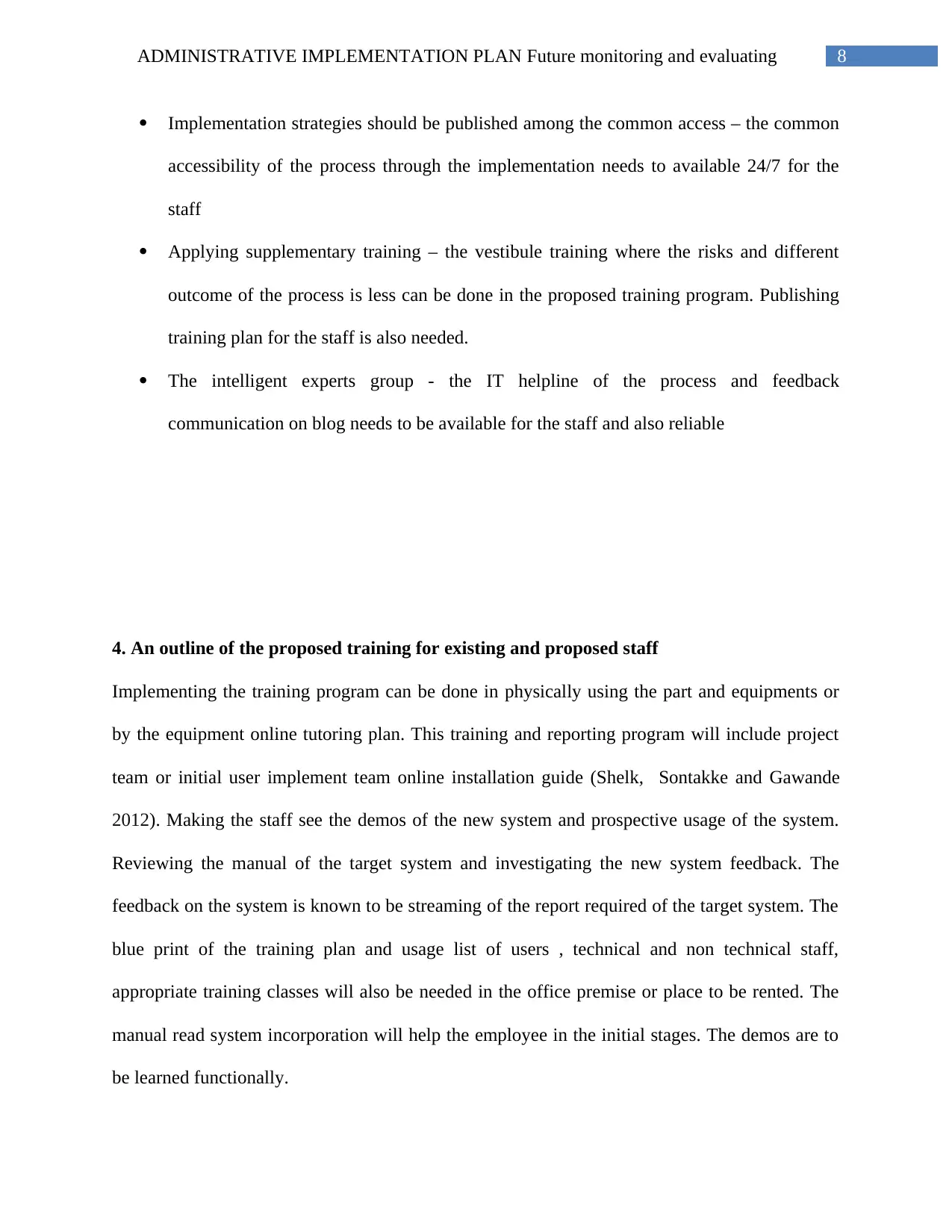
8ADMINISTRATIVE IMPLEMENTATION PLAN Future monitoring and evaluating
Implementation strategies should be published among the common access – the common
accessibility of the process through the implementation needs to available 24/7 for the
staff
Applying supplementary training – the vestibule training where the risks and different
outcome of the process is less can be done in the proposed training program. Publishing
training plan for the staff is also needed.
The intelligent experts group - the IT helpline of the process and feedback
communication on blog needs to be available for the staff and also reliable
4. An outline of the proposed training for existing and proposed staff
Implementing the training program can be done in physically using the part and equipments or
by the equipment online tutoring plan. This training and reporting program will include project
team or initial user implement team online installation guide (Shelk, Sontakke and Gawande
2012). Making the staff see the demos of the new system and prospective usage of the system.
Reviewing the manual of the target system and investigating the new system feedback. The
feedback on the system is known to be streaming of the report required of the target system. The
blue print of the training plan and usage list of users , technical and non technical staff,
appropriate training classes will also be needed in the office premise or place to be rented. The
manual read system incorporation will help the employee in the initial stages. The demos are to
be learned functionally.
Implementation strategies should be published among the common access – the common
accessibility of the process through the implementation needs to available 24/7 for the
staff
Applying supplementary training – the vestibule training where the risks and different
outcome of the process is less can be done in the proposed training program. Publishing
training plan for the staff is also needed.
The intelligent experts group - the IT helpline of the process and feedback
communication on blog needs to be available for the staff and also reliable
4. An outline of the proposed training for existing and proposed staff
Implementing the training program can be done in physically using the part and equipments or
by the equipment online tutoring plan. This training and reporting program will include project
team or initial user implement team online installation guide (Shelk, Sontakke and Gawande
2012). Making the staff see the demos of the new system and prospective usage of the system.
Reviewing the manual of the target system and investigating the new system feedback. The
feedback on the system is known to be streaming of the report required of the target system. The
blue print of the training plan and usage list of users , technical and non technical staff,
appropriate training classes will also be needed in the office premise or place to be rented. The
manual read system incorporation will help the employee in the initial stages. The demos are to
be learned functionally.
⊘ This is a preview!⊘
Do you want full access?
Subscribe today to unlock all pages.

Trusted by 1+ million students worldwide
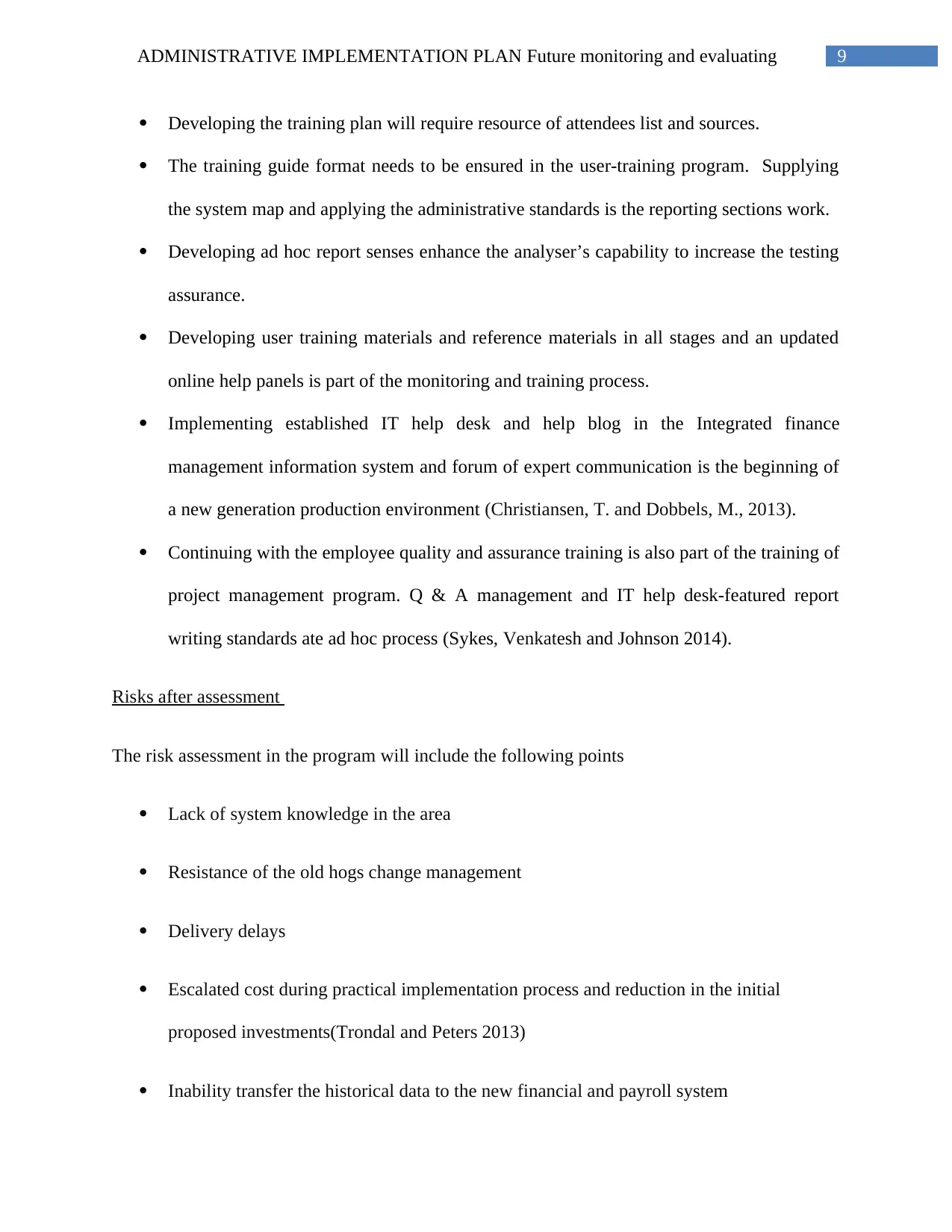
9ADMINISTRATIVE IMPLEMENTATION PLAN Future monitoring and evaluating
Developing the training plan will require resource of attendees list and sources.
The training guide format needs to be ensured in the user-training program. Supplying
the system map and applying the administrative standards is the reporting sections work.
Developing ad hoc report senses enhance the analyser’s capability to increase the testing
assurance.
Developing user training materials and reference materials in all stages and an updated
online help panels is part of the monitoring and training process.
Implementing established IT help desk and help blog in the Integrated finance
management information system and forum of expert communication is the beginning of
a new generation production environment (Christiansen, T. and Dobbels, M., 2013).
Continuing with the employee quality and assurance training is also part of the training of
project management program. Q & A management and IT help desk-featured report
writing standards ate ad hoc process (Sykes, Venkatesh and Johnson 2014).
Risks after assessment
The risk assessment in the program will include the following points
Lack of system knowledge in the area
Resistance of the old hogs change management
Delivery delays
Escalated cost during practical implementation process and reduction in the initial
proposed investments(Trondal and Peters 2013)
Inability transfer the historical data to the new financial and payroll system
Developing the training plan will require resource of attendees list and sources.
The training guide format needs to be ensured in the user-training program. Supplying
the system map and applying the administrative standards is the reporting sections work.
Developing ad hoc report senses enhance the analyser’s capability to increase the testing
assurance.
Developing user training materials and reference materials in all stages and an updated
online help panels is part of the monitoring and training process.
Implementing established IT help desk and help blog in the Integrated finance
management information system and forum of expert communication is the beginning of
a new generation production environment (Christiansen, T. and Dobbels, M., 2013).
Continuing with the employee quality and assurance training is also part of the training of
project management program. Q & A management and IT help desk-featured report
writing standards ate ad hoc process (Sykes, Venkatesh and Johnson 2014).
Risks after assessment
The risk assessment in the program will include the following points
Lack of system knowledge in the area
Resistance of the old hogs change management
Delivery delays
Escalated cost during practical implementation process and reduction in the initial
proposed investments(Trondal and Peters 2013)
Inability transfer the historical data to the new financial and payroll system
Paraphrase This Document
Need a fresh take? Get an instant paraphrase of this document with our AI Paraphraser
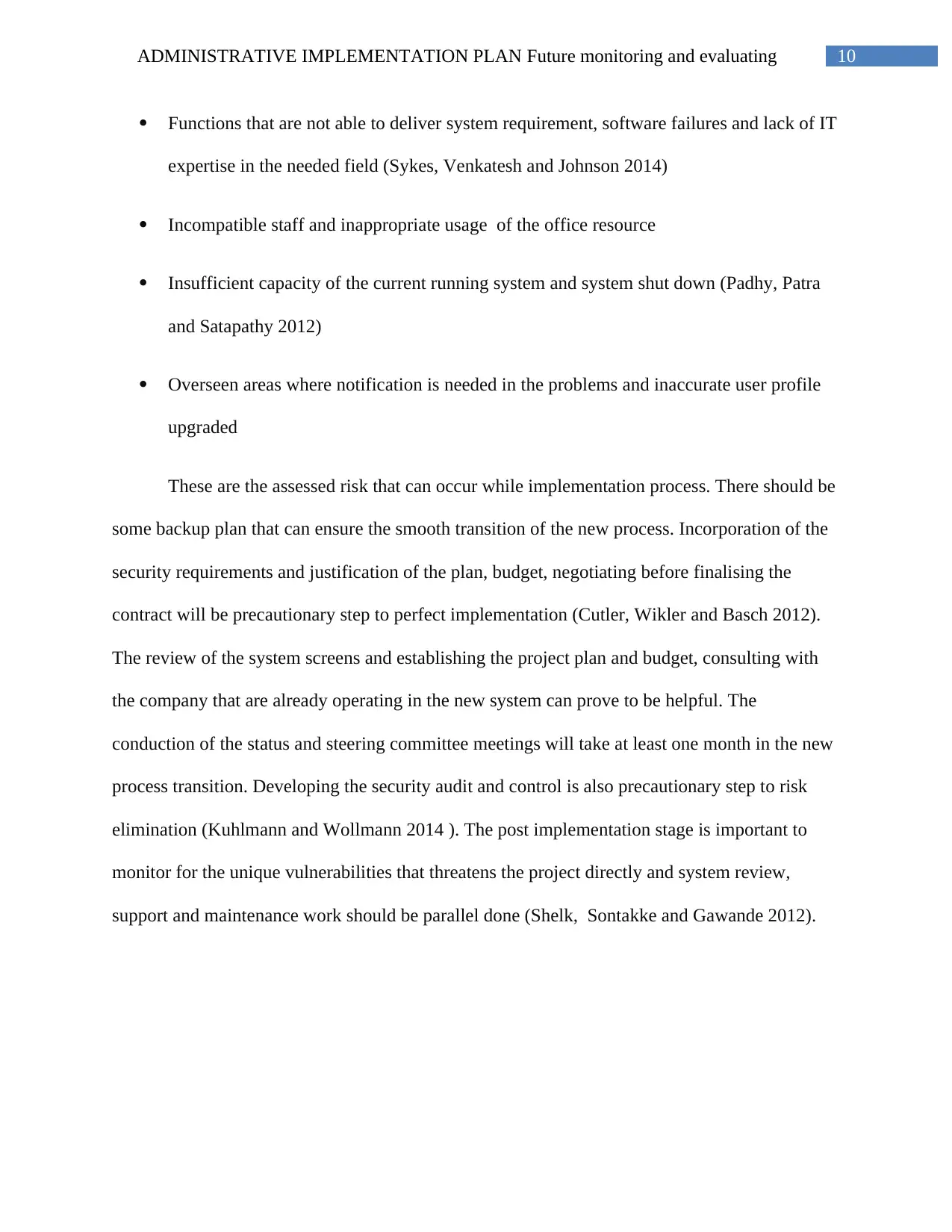
10ADMINISTRATIVE IMPLEMENTATION PLAN Future monitoring and evaluating
Functions that are not able to deliver system requirement, software failures and lack of IT
expertise in the needed field (Sykes, Venkatesh and Johnson 2014)
Incompatible staff and inappropriate usage of the office resource
Insufficient capacity of the current running system and system shut down (Padhy, Patra
and Satapathy 2012)
Overseen areas where notification is needed in the problems and inaccurate user profile
upgraded
These are the assessed risk that can occur while implementation process. There should be
some backup plan that can ensure the smooth transition of the new process. Incorporation of the
security requirements and justification of the plan, budget, negotiating before finalising the
contract will be precautionary step to perfect implementation (Cutler, Wikler and Basch 2012).
The review of the system screens and establishing the project plan and budget, consulting with
the company that are already operating in the new system can prove to be helpful. The
conduction of the status and steering committee meetings will take at least one month in the new
process transition. Developing the security audit and control is also precautionary step to risk
elimination (Kuhlmann and Wollmann 2014 ). The post implementation stage is important to
monitor for the unique vulnerabilities that threatens the project directly and system review,
support and maintenance work should be parallel done (Shelk, Sontakke and Gawande 2012).
Functions that are not able to deliver system requirement, software failures and lack of IT
expertise in the needed field (Sykes, Venkatesh and Johnson 2014)
Incompatible staff and inappropriate usage of the office resource
Insufficient capacity of the current running system and system shut down (Padhy, Patra
and Satapathy 2012)
Overseen areas where notification is needed in the problems and inaccurate user profile
upgraded
These are the assessed risk that can occur while implementation process. There should be
some backup plan that can ensure the smooth transition of the new process. Incorporation of the
security requirements and justification of the plan, budget, negotiating before finalising the
contract will be precautionary step to perfect implementation (Cutler, Wikler and Basch 2012).
The review of the system screens and establishing the project plan and budget, consulting with
the company that are already operating in the new system can prove to be helpful. The
conduction of the status and steering committee meetings will take at least one month in the new
process transition. Developing the security audit and control is also precautionary step to risk
elimination (Kuhlmann and Wollmann 2014 ). The post implementation stage is important to
monitor for the unique vulnerabilities that threatens the project directly and system review,
support and maintenance work should be parallel done (Shelk, Sontakke and Gawande 2012).
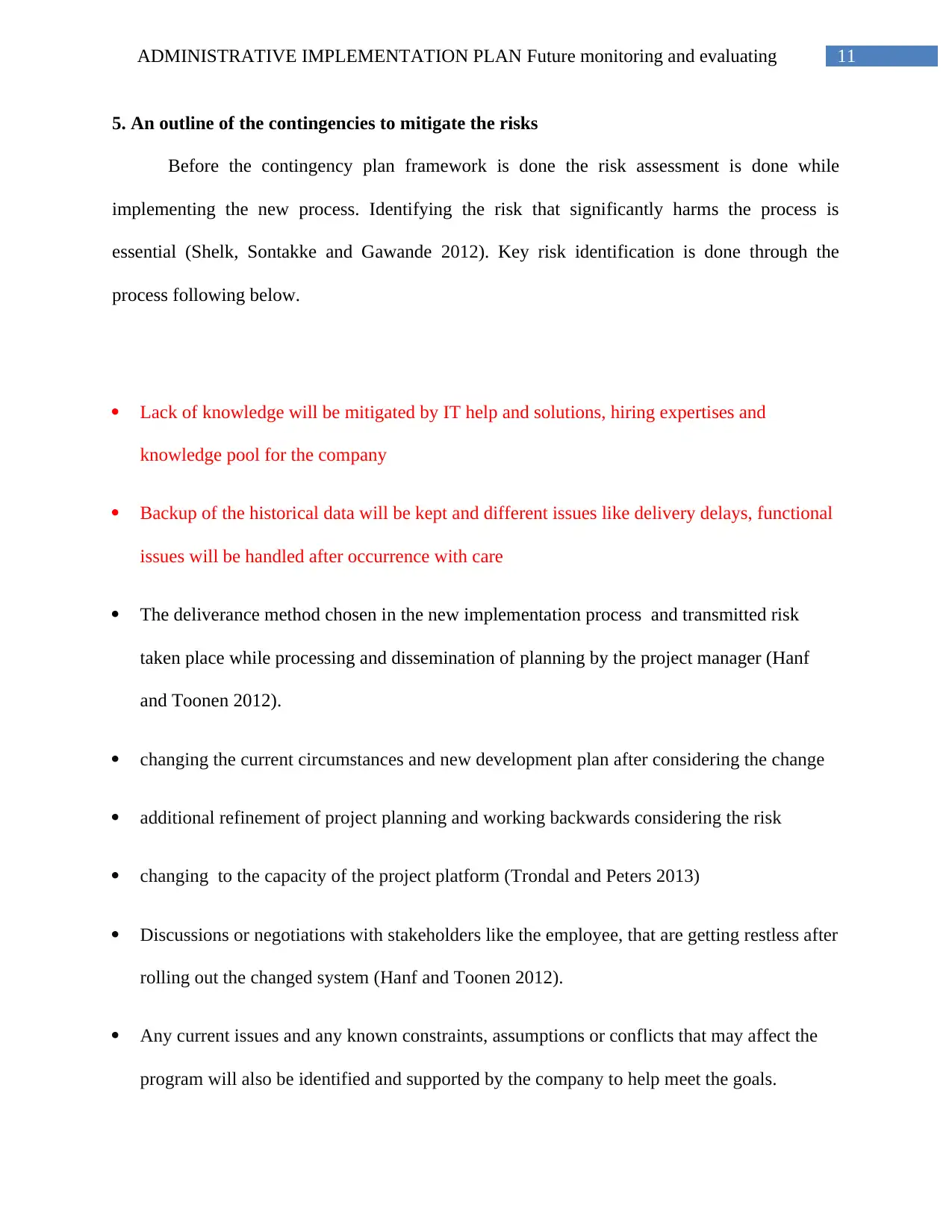
11ADMINISTRATIVE IMPLEMENTATION PLAN Future monitoring and evaluating
5. An outline of the contingencies to mitigate the risks
Before the contingency plan framework is done the risk assessment is done while
implementing the new process. Identifying the risk that significantly harms the process is
essential (Shelk, Sontakke and Gawande 2012). Key risk identification is done through the
process following below.
Lack of knowledge will be mitigated by IT help and solutions, hiring expertises and
knowledge pool for the company
Backup of the historical data will be kept and different issues like delivery delays, functional
issues will be handled after occurrence with care
The deliverance method chosen in the new implementation process and transmitted risk
taken place while processing and dissemination of planning by the project manager (Hanf
and Toonen 2012).
changing the current circumstances and new development plan after considering the change
additional refinement of project planning and working backwards considering the risk
changing to the capacity of the project platform (Trondal and Peters 2013)
Discussions or negotiations with stakeholders like the employee, that are getting restless after
rolling out the changed system (Hanf and Toonen 2012).
Any current issues and any known constraints, assumptions or conflicts that may affect the
program will also be identified and supported by the company to help meet the goals.
5. An outline of the contingencies to mitigate the risks
Before the contingency plan framework is done the risk assessment is done while
implementing the new process. Identifying the risk that significantly harms the process is
essential (Shelk, Sontakke and Gawande 2012). Key risk identification is done through the
process following below.
Lack of knowledge will be mitigated by IT help and solutions, hiring expertises and
knowledge pool for the company
Backup of the historical data will be kept and different issues like delivery delays, functional
issues will be handled after occurrence with care
The deliverance method chosen in the new implementation process and transmitted risk
taken place while processing and dissemination of planning by the project manager (Hanf
and Toonen 2012).
changing the current circumstances and new development plan after considering the change
additional refinement of project planning and working backwards considering the risk
changing to the capacity of the project platform (Trondal and Peters 2013)
Discussions or negotiations with stakeholders like the employee, that are getting restless after
rolling out the changed system (Hanf and Toonen 2012).
Any current issues and any known constraints, assumptions or conflicts that may affect the
program will also be identified and supported by the company to help meet the goals.
⊘ This is a preview!⊘
Do you want full access?
Subscribe today to unlock all pages.

Trusted by 1+ million students worldwide
1 out of 18
Related Documents
Your All-in-One AI-Powered Toolkit for Academic Success.
+13062052269
info@desklib.com
Available 24*7 on WhatsApp / Email
![[object Object]](/_next/static/media/star-bottom.7253800d.svg)
Unlock your academic potential
Copyright © 2020–2025 A2Z Services. All Rights Reserved. Developed and managed by ZUCOL.




